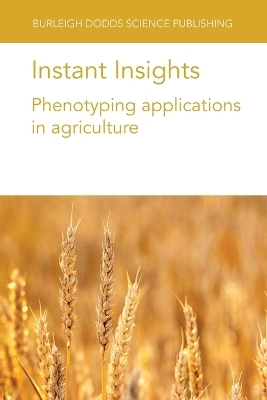
Instant Insights: Phenotyping Applications in Agriculture
Burleigh Dodds Science Publishing Limited (Verlag)
978-1-80146-655-4 (ISBN)
This book features five peer-reviewed reviews on the different applications of phenotyping techniques across agriculture.
The first chapter outlines how plant phenotyping has developed over recent decades, driven by factors such as advances in optical sensors, image analysis and automation as well as multidisciplinary cooperation in establishing facilities for high-throughput plant phenotyping.
The second chapter reviews the importance of phenotyping in plant breeding programmes and considers the role of phenomics in boosting the genetic gain in grain yields. Using high-throughput phenotyping techniques as a cost-efficient method for phenotypic data acquisition is also discussed.
The third chapter examines recent advances in phenotyping to identify drought-resistance traits in cereal roots. It also reviews current root phenotyping strategies and challenges.
The fourth chapter considers the application of phenotyping techniques based on existing plant cohort research in plant factories with artificial lighting (PFALs). The chapter also explores the possibility of plant phenotype-based environmental control in PFALs.
The final chapter provides an overview of the imaging techniques used in seed phenotyping, focussing primarily on the recent advances in X-ray imaging and the main parameters required to produce optimal image data.
Roland Pieruschka is currently a plant scientist at the Forschungszentrum Jülich, IBG2: Plant Sciences after his PhD at the University of Düsseldorf and Postdoc at the Carnegie Institution in Stanford. He has been interested in physiological concepts and plant-environment interactions, particularly plant phenotyping, which he combines with establishment and coordination of international plant phenotyping research infrastructures (EMPHASIS), research infrastructure projects (EPPN, EPPN2020), international networks (IPPN). Dr Eri Hayashi is the President of the JPFA, where she is also the Director of International Relations and Consulting. Eri was Research Project Leader for a national project on Artificial Intelligence- and Phenotyping-based Smart Plant Factories with Artificial Lighting (PFALs). She leads a number of international projects on technology development, has given presentations at a number of international conferences, and has written widely on the topic of smart plant factories. She was a co-convener of the Symposium of Advances in Vertical Farming at the 31st International Horticultural Congress (IHC 2022). She led the JPFA in organizing the first JPFA International Symposium on Plant Factory (ISPF 2023) at Kashiwanoha, Japan.
Chapter 1 - Origins and drivers of crop phenotyping: Roland Pieruschka and Ulrich Schurr, Institute for Bio- and Geosciences (IBG), IBG-2: Plant Sciences, Forschungszentrum Jülich, Germany;
1 Introduction
2 Technological progress in plant phenotyping
3 Community integration in plant phenotyping
4 Plant phenotyping as a tool for enhanced and sustainable crop production
5 Future trends
6 Where to look for further information
7 Acknowledgements
8 References
Chapter 2 - Advances in seed phenotyping using X-ray imaging: Sherif Hamdy, Aurélie Charrier and Laurence Le Corre, GEVES, France; Pejman Rasti, Université d’Angers and École d’ingénieur Informatique et Environnement (ESAIP), France; and David Rousseau, Université d’Angers, France;
1 Introduction
2 Sample preparation
3 Projection acquisition
4 Image reconstruction
5 Image processing
6 Conclusion and outlook
7 Future trends
8 Where to look for further information
9 References
Chapter 3 - Using phenotyping techniques to predict and model grain yield: translating phenotyping into genetic gain: Thomas Vatter and José L. Araus, University of Barcelona and AGROTECNIO (Center for Research in Agrotechnology), Spain;
1 Introduction
2 Boosting genetic gain in grain yield by focusing on phenomics
3 Stomatal conductance
4 Functional stay green
5 Case study
6 Conclusion and future trends
7 Where to look for further information
8 References
Chapter 4 - Advances in phenotyping to identify drought-resistance traits in cereal roots: John (Jack) Christopher, University of Queensland QAAFI, Australia;
1 Introduction
2 Root phenotyping strategies and challenges
3 Root traits to improve drought adaptation in cereals
4 Phenotyping in controlled conditions: ex-situ
5 Field phenotyping
6 Three-dimensional imaging and root interactions with the soil
7 Imaging and trait data extraction
8 Above ground correlated traits in the field
9 Trait by environment interactions
10 Phenotyping methods for genomic selection and molecular breeding
11 Case study: Late, deep root development in sub-tropical wheat
12 Conclusion and future trends
13 Where to look for further information
14 Acknowledgements
15 References
Chapter 5 - Plant phenotyping of individual plants towards optimal environmental control in plant factories: Eri Hayashi, Japan Plant Factory Association, Japan;
1 Introduction
2 Current challenges with plant factories with artificial lighting
3 Plant phenotyping
4 Plant phenotyping in plant factories with artificial lighting
5 Plant cohort research in plant factories with artificial lighting
6 Phenotype-based environmental control in plant factories with artificial lighting
7 Conclusion
8 Acknowledgements
9 References
| Erscheinungsdatum | 25.01.2024 |
|---|---|
| Reihe/Serie | Burleigh Dodds Science: Instant Insights |
| Zusatzinfo | Color tables, photos and figures |
| Verlagsort | Cambridge |
| Sprache | englisch |
| Maße | 152 x 229 mm |
| Gewicht | 201 g |
| Themenwelt | Naturwissenschaften ► Biologie ► Botanik |
| Weitere Fachgebiete ► Land- / Forstwirtschaft / Fischerei | |
| ISBN-10 | 1-80146-655-6 / 1801466556 |
| ISBN-13 | 978-1-80146-655-4 / 9781801466554 |
| Zustand | Neuware |
| Haben Sie eine Frage zum Produkt? |
aus dem Bereich


